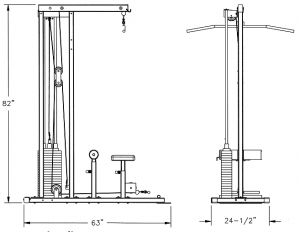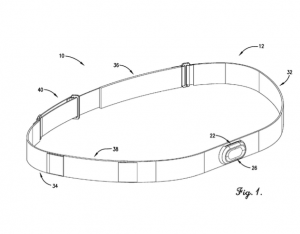Many common diseases such as Multiple sclerosis, Cerebral palsy, and Post-polio syndrome as well as traumatic brain and spinal cord injury, strokes, and tumors can lead to Paraplegia, or paralysis below the waist. While paraplegia of course is limiting, upper-body exercise and strength building is vital to establish an active, independent, healthy lifestyle. Exercise for those with spinal cord injuries and paralysis have also been shown to decrease the risk of developing many associated secondary conditions such as osteoporosis, cardiovascular disease, pressure ulcers, urinary tract infections, diabetes and arthritis. Exercising has also been shown to control pain, improve mental health, and maintain a healthy weight for those with limited mobility. However, the number of possible exercises are limited by a lack of accessible equipment and resources for people with limited mobility.
Image 1. Diagram of muscle groups targeted by the lateral pull down machine.
An example of a piece of equipment that could increase upper body strength is a lateral pull down machine as shown above in Image 1. This machine is used in a sitting position and the user grasps the bar with palms facing forward and pulls the bar down toward their chest. This exercise targets the rhomboid major, latissimus dorsi muscles, located on the sides of your rib cage, the biceps, the lower trapezius, and the posterior deltoid in the back of the shoulder, all of which contribute to a stronger upper body.
Because this piece of equipment is composed of a bench and thigh stabilizer, someone in a wheelchair would not be able to use it to build their upper body strength without assistance to move out of their wheelchair. This is an issue for several pieces of upper body strengthening equipment. The question is, how could these pieces of equipment, the lateral pull up bar particularly, be altered to provide more independent access to those in wheelchairs without taking away from their current effectiveness? If this question were to be solved, perhaps it could lead those with limited mobility to feel more comfortable at community gyms and provide them with a means to exercise more independently.
Assumptions and Estimations:
- Average arm length (young man with average height): 25 inches
- Average armrest of wheelchairs: 30 inches
- Height of resting bar combines the height of the armrest of the wheelchair and average arm length above, minus 5 inches to account for women as well
- Average height of chairs: 19 inches
- People perform pull down correctly and reach straight up to get bar
- We are calculating force at hinge, each horizontal measurement to calculate moment is taken from this origin
- Height of bench is 2 inches (measured at UD gym)
- Height of stabilizer varies, but maximum would be 7 inches away (measured at UD gym)
- Weight of bench is 5lbs
- Weight of stabilizer is 1lb
- Weight of each member is 6lbs
Image 2. Dimensions of standard Stack Loaded Lat Machine by Deltech Fitness, shows typical set up of the Lateral Pull Down Machine
As shown in Image 2 above, which is similar to most lateral pull down machines, the first aspect that requires adjustment is the dimensions. The width of the area where the wheelchair could pull in would have to be increased to a width greater than 32 inches in order to meet ADA standards for doorways. The bench and thigh stabilizer would also have to be adjusted so it could be cleared away from the area in which the wheelchair will sit. This machine can be altered by increasing the width to 33 inches and implementing a foldable bench/stabilizer mechanism that can be pushed up to the left or right side as shown below in Image 3a and 3b.
Image 3a (top) and 3b (bottom): 3a – Overlooking design of lateral pull down machine with updated dimensions that allow those in wheelchairs to access, as well as a removable bench that can be folded up. 3b – Image of bench and members in folded up position showing weight distribution centered around the hinge.
Using the following equation to determine moment on hinge:
|Mo| = (Force) * (Perpendicular distance)
and taking into account all assumptions and measurements used, the torque on the hinge can be calculated using the following values:
(Wbench*Distancebench) + (Wstabilizer *Distancestabilizer ) +(Wmember1 + Wmember2)*(Distancemembers)
(5lbs*20in)+(1lb*28in)+(12lb*9.5in) = 242 lb*in
The total torque on the hinge calculated is 242 pound inches. An off-set hinge made out of stainless can be used which provides a greater length on the ground to counter the force caused by the hanging bench. Reaching the bar is another issue for those in wheelchairs. To combat this issue, the wire can be lengthened so that the resting position of the bar should be 50 inches off the ground in order to provide access to those who are sitting without having to get up.
This solution is assuming a standard size of wheelchairs which is used by the ADA when performing construction of doorways, however, wheelchair height and widths do change and not all will be able to fit in this gap. Exceptionally tall people may also suffer from these changes, as the wire length increase was done to help an average height or lower person. Those who are a lot taller may not gain full effectiveness of a pull down if they are starting lower than the top of their arm span reaches. This solution is indeed reasonable for those that have disabilities requiring the use of wheelchairs, however it is difficult to enact global changes such as this for development of equipment as the majority of users have the ability to use machines like this without these changes. Changes have to be encouraged by all to improve the accessibility to healthcare and exercise to all groups, even those who are marginalized. The value for the torque on the hinge makes sense, as it is carrying the full weight of the bench and the members that typically support the full weight of the user.
This solution may also need to be adjusted because sometimes gyms are limited in size and may not be interested in the fold up chair that could potentially take up more space than the original version. Coming back to the original question, this solution shows that equipment like the lateral pull down machine can be used for those who are disabled, and the development of this in gyms should be encouraged. Those with disabilities deserve the same opportunities to create a healthy lifestyle and feeling of community that comes with working out in a gym. The more independently they are able to do this, the more inclined they will be to continue. T changes in dimensions of the typical machine as well as the moveable bench allow that for those who typically would be unable to build their upper body strength in this way the ability to do so.
Additional Resources:
http://www.spinalcord.com/types-of-paralysis
https://www.ncbi.nlm.nih.gov/pmc/articles/PMC2694784
https://www.karmanhealthcare.com/how-wide-does-a-doorway-need-to-be-for-a-wheelchair/
http://www.livestrong.com/article/503333-what-are-the-benefits-of-a-lat-pulldown/






